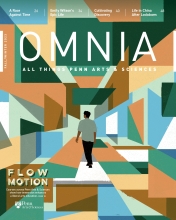Conservation, Justice, and Gender
Through her Penn Undergraduate Research Mentoring summer internship, Mia McElhatton, C’26, explored how efforts to save the planet may disproportionately burden women.
What happens when our moral commitments to non-human nature conflict with our commitments to social justice? How can we integrate our obligations to animals and fellow human beings? These research questions, posed in the description for Philosophy professor Kok-Chor Tan’s Penn Undergraduate Research Mentoring Program (PURM) project, grabbed the attention of Mia McElhatton, C’26.
McElhatton is intrigued by political philosophy and ideas around personhood—who is considered a “person,” including whether and when this designation applies to animals and the environment. Those interests dovetail with a curiosity about environmental equity and feminist theory she developed in high school.
So, when Tan’s PURM project—an opportunity to assist with research on his current book, Justice in Conservation: The Ethics and Politics of Wildlife Conservation—married so many of McElhatton’s interests, it seemed almost too good to be true. She applied for and got the internship, offered through the Center for Undergraduate Research and Fellowships (CURF). The program provides rising sophomores or juniors at Penn a chance to spend 10 weeks working with Penn faculty, along with a $5,000 award for the summer.
Through her PURM experience, McElhatton is learning from a leading philosophical scholar about how a book project in the field is conceived, framed, and carried out, and familiarizing herself with the philosophical literature on animal ethics, politics, and social justice. Tan has also encouraged her to develop her own research questions about how environmentalism can better align with human interests and social justice. For her project, she’s homing in on how conservationists respond to women and those who identify as women.
Conflicts within Conservation
Tan’s research primarily focuses on philosophy and global justice, asking questions about the distribution of resources around the world, and he’s taught classes on morality and environmental justice in the past. This book project couples those interests, delving into environmental justice in western and non-western countries, between humans and animals and the natural world, and within Indigenous cultures, to name a few. Tan plans to investigate what happens when the commitment to human beings and the commitment to animals and the natural world clash in the context of conservation efforts.
I’ve been doing preliminary research on the specific impact of conservation efforts on women or people who are gendered as women, looking at motherhood, reproduction, and sex as overlapping but somewhat unique categories.
Though the book is still in its early stage, Tan says he hopes it will raise awareness about growing moral and ethical questions around wildlife conservation. “Most of us believe that wildlife and environmental conservation is a moral imperative. It is also a given that we have obligations of social and global justice to each other,” he says. “So, what should we do when there is a moral conflict between what we owe to non-human animals and what we owe to people? Are the goals of global poverty eradication and biodiversity conservation at odds? Is social justice in conservation achievable? How do we share the burdens and the benefits of conservation more equitably?”
Such philosophical environmental justice questions energize McElhatton, as does the chance to see firsthand how a career in academic research looks. She plans to major in philosophy and hopes to eventually work in academia.
For McElhatton’s first task this summer, she conducted a thorough literature review of recent articles in journals and books focused on biological conservation and environmental and animal ethics. She also sought real-world examples of conservation justice challenges. Through the latter, she saw how conservation efforts can have unique gender dynamics. This led to her current project on how conservationism may inequitably harm women and those who identify as women.
Probing Gender Inequities within Conservation
“I’ve been doing preliminary research on the specific impact of conservation efforts on women or people who are gendered as women, looking at motherhood, reproduction, and sex as overlapping but somewhat unique categories,” explains McElhatton, who cites a few examples, including the death of a child by a chimpanzee in Tanzania.
She explains that in response to the child’s death, which happened in the presence of the child’s mother, the larger environmental movement rallied behind protecting the life of the animal, while the environmental community criticized the mother, placing blame for the child’s death at her feet.
“For me, that’s an interesting instance where conservation imposes disproportionately more risks on some people, in particular women,” says McElhatton. Acknowledging and addressing tensions of this sort—human-wildlife conflict in local communities—is one challenge of conservation justice, says Tan. But he says that McElhatton adds a new perspective, “which she’s arrived at on her own.”
McElhatton’s independent research is “closely related, but different” to what Tan is focusing on in his book, which will primarily look at three dimensions of conservation justice: distributive, deliberative, and cultural justice. “What Mia has done is identify a fourth question, that of gender justice, which I believe is a fruitful topic for her to explore and build upon,” Tan says. He notes that because of McElhatton’s work, his book will pay more attention to the distinct problem of gender justice than it would have otherwise.
McElhatton, now more than halfway through her summer program, plans to finetune her research skills under the tutelage of Tan and dig deeper into issues of gender and conservation. She’ll present her work at a the CURF Fall Research Expo on September 18, a showcase of PURM projects from this summer, and she hopes to continue working under Tan’s mentorship this coming semester.





